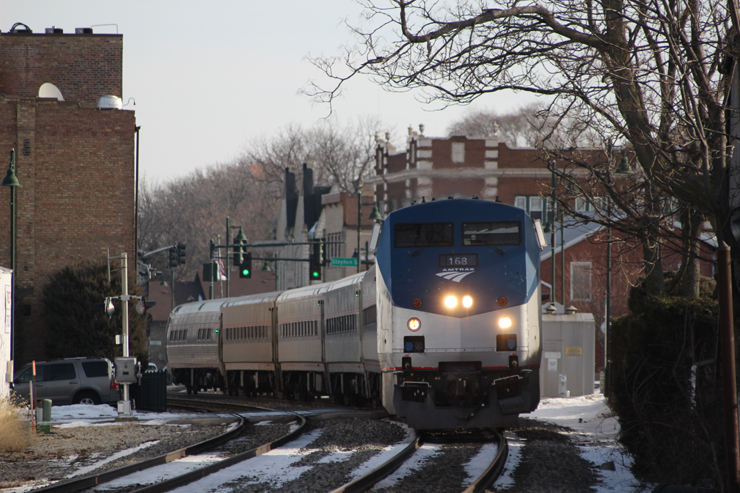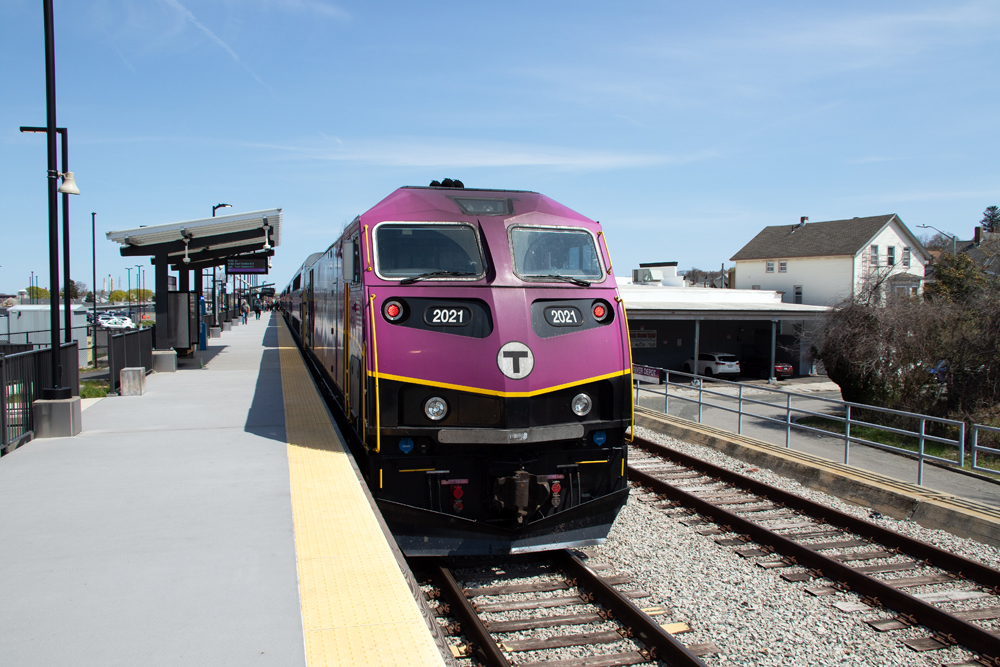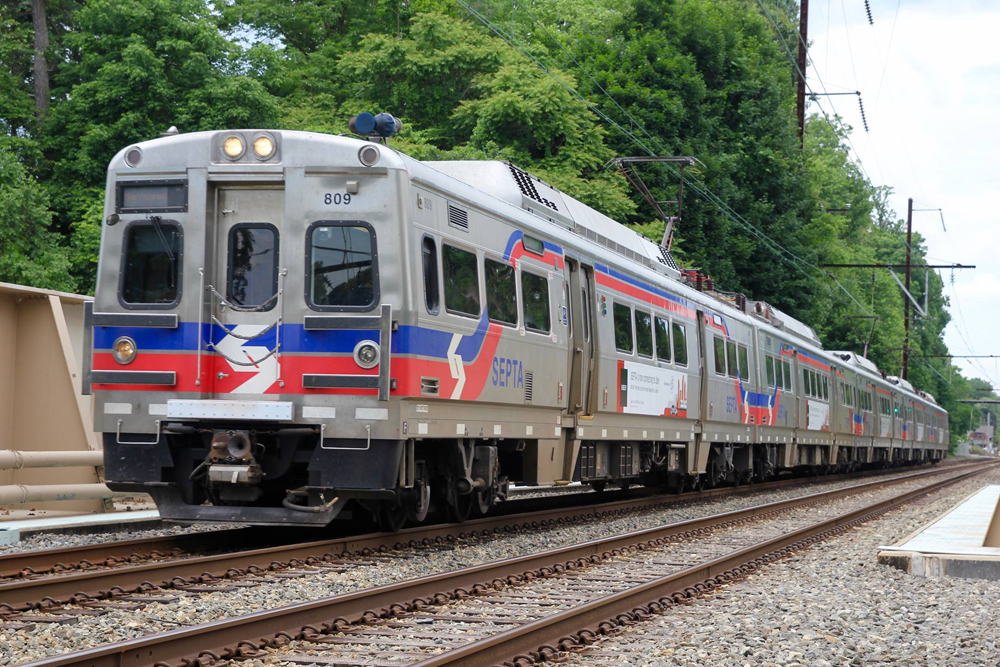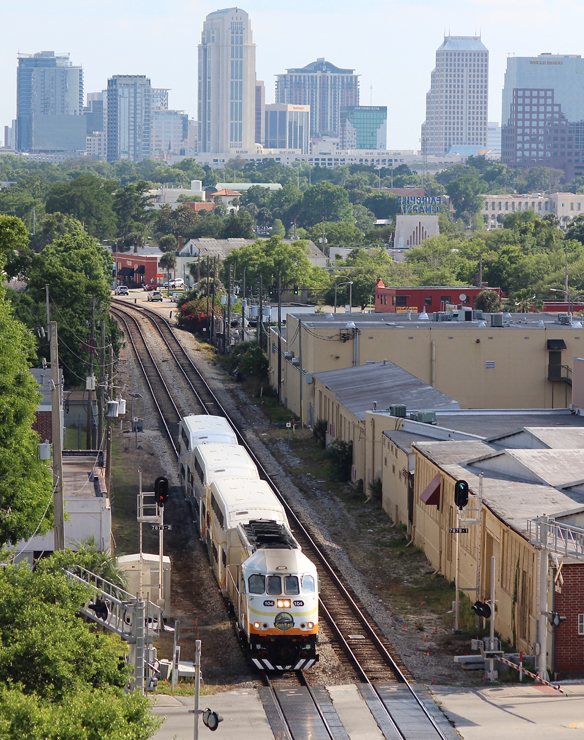“These are two big programs for us,” Anderson is reported to have told employees. “We want to get a [Request for Proposals] completed and contracts awarded this year. There is no reason why we can’t.”
The passenger carrier will seek “more modern, lightweight, environmentally sensitive, [Americans with Disabilities Act]-compliant equipment that will give us a completely different product,” Anderson continued. He cited the DMU trainsets for commuter services in Fort Worth, Texas (to open in early 2019), and Santa Rosa-San Rafael, Calif. (which began service in mid-2017), as models for the “modern way of train travel.”
“If we want to appeal to a millennial generation in high-density urban markets, we need the same kind of modern unit trains we see operating in Europe and Asia,” he declared. “Making these investments now will benefit the next generation of Amtrak.”
When asked to elaborate, Amtrak spokeswoman Kimberly Woods told Trains News Wire, “We’ll provide information on future plans on equipment when details are finalized.”















Amtrak desperately needs new equipment especially since the majority of their locomotives and coaches are 40 years plus. But aside from the usual ptfalls of a hostile federal government and indifferent officials as well as oppostion by host freight carriers, Amtrak has to get to work and embark on a massive marketing campaign and strategy as well as extensive public relations to turn the mindset of Americans that taking the train is a perfectly and socialable way to travel and enjoy the scenic wonders of this great country. New equipment alone is not going to turn things around or get people back to riding trains. They have to improve their product which also means a one on train service and ammenties as well as travel discounts and perks to get people back to riding a train as well as friendly and caring onboard staff and crew. The airlines know how to attract passengers and keep them not only by quick travel times but by the care and ammneties and discounts that are offered. Amtrak will have to take some and learn some things from how the airlines are sucessful with their operations and business
New Equipment is needed and will help but Amtrak needs to improve in areas of marketing, passenger ammenties, service and reliability and courtesy and car by their staff as well.
The problem is you need modern track first. Anderson needs to realize he’s not running an airline anymore. Besides, trainsets mean one bad car takes out the set instead of just the car. I am also not sure that basing the cars off lightweight commuter cars is the right idea for long distance trains…or is he planning to axe the western routes.
“Branding” and “marketing” true first-class service is a dilemma for Amtrak. Publicly-funded services aren’t supposed to be luxurious in competition with private services. Even though there are no private trains, luxury services on Amtrak could be seen as tempting market share away from private enterprise (buses and airlines) at public expense. So how to balance the economic imperative of making Amtrak service competitively appealing without violating the principal of non-competition with the private sector? Good question.
I have long thought that Amtrak needs to look seriously at modern MU technology for short-haul trains, and I’m glad they are finally doing it. Locomotive-hauled trains do have flexibility for swapping equipment in/out, but it is silly to use a huge P42 for a short-distance three-car train. Lighter, more agile equipment makes sense to me. The Brightline equipment that was favorably reviewed in a recent issue of Trains was engineered to NEC clearances, obviously with an eye toward a larger market.
Track capacity remains an issue. High-volume freight lines that don’t have room for additional locomotive-hauled trains won’t have room for MUs, either. That’s a separate problem, one that could be solved (at great expense) with separate freight and passenger ROWs, but that can’t be done if we continue insist that passenger service be justified by high enough freight business to be worth maintaining a given track to passenger standards for passenger trains that can’t be run because there are too many freight trains.
SMART (Sonoma County to Marin County) commuter service is great for fixed trainsets, but probably wouldn’t really work for most Amtrak routes.
He doesn’t even mention the Horizon fleet. What happens to them? Additionally, fixed consist are not an answer for peak time frames which will limit passenger numbers overall. Frequencies will have to be increased to make up the difference.
Don’t forget that the P42s don’t require Blue Juice like most new passenger locomotives.
That’s a whole new logistic mess on freight lines.
I’m a little late to this, but Amtrak would need some serious funding if it’s going to run semiperminenatly coupled trains. You need a second unit for any breakdown, just look at the talgos out west. I like the idea and think outside the Midwest it has a chance. But our nice winters, are Europe’s deep freezes, and not bring able to quickly pull out a bad order will really mess up the system.
New coaches are sorely needed. If Amtrak in fact wants “to appeal to a millennial generation in high-density urban markets…” Brightline is a far better model than the DMU Commuter services Anderson cites.
How about actual First Class service on each train that is in fact FIRST CLASS? Bring back the “Parlor Car” model (large Seat, In seat dining, In seat entertainment, WI-FI etc….) . Every time I take the Acela, I gladly pay for a First Class single seat and the always full car is a affirmation that others demand and are willing to pay extra for this service. First Class service is a normal expectation in Europe and can certainly be a large revenue generator for Amtrak.
Modern marketing & branding is something that Amtrak truly lacks. People are excited about Brightline. Would they have been as excited about “All Aboard Florida” with push-pull bi-level coaches that looked like a commuter train as originally envisioned?
There is nothing wrong with the flexible locomotive/coach model that modern branding and outside the box thinking cannot improve. One only needs to look at Virgin Trains or GWR in the U.K. as models of modern intercity high speed train service that is attractive to today’s customer. It only takes vision.
I get it and applaud Amtrak for taking a fresh look at everything they are doing. It may make some people unhappy, but the cold fact is that Amtrak may need to change their offering. Europe has given up on sleeper trains; perhaps it’s time for Amtrak to forego recreating the past and instead create the future of rail travel in the USA,
BRADLEY CUPP – Not much difference between a Dash 8 and Dash 9. NS has had good results with AC conversion of Dash 9s. Amtrak P32s are lighterweight versions of P42 and have AC propulsion. Plenty of reason to think AC rebuild of P42 would work well.
JOHN HEFFNER – John you are correct the Midwest, where I live, needs more trains. Many many more trains. How to get them? “Bonehead politicians – most of them Republicans” you post. I voted for Scott Walker if that’s among those “bonehead” Republicans you are referring to. (He killed the proposed Madison train while supporting the Hiawatha.) At a certain point, Amtrak needs to prove its economic utility. Piling a state subsidy on top of a federal subsidy doesn’t make a train economical. I agree with you that ONE TRAIN PAIR in Cleveland is a disgrace (or Atlanta or Minneapolis/ St. Paul, or three train pairs in Detroit). The question is, how to increase that number. Got any ideas? I’ve been at MSP airport and seen a big number of planes loading, at a city with one train pair in 24 hours. Three train pairs in Detroit? I’ve stood north of DTW Detroit Metro Airport and (in low light so the landing lights are visible) in one glance seen eight planes landing. So, John, you tell me how to make more trains in the Midwest more economical.
The key tp starting the sort of frequent short to medium distance trips that Mr. Jarman suggests is eliminating the provision in PRIIA/PRRIA that Amtrak interprets as requiring states to sponsor services under 750 miles. So long as bonehead politicians (and most of them are Republicans) are running states like Indiana and Ohio, there will be no short or medium distance services unless Amtrak initiates them as “national routes”
This is good thinking for some short or medium distance routes. Aside from coaches, the consist should include a true first class car with at your seat dining, a bistro/lounge car with the ability to serve some meals freshly prepared on board, and a baggage section that would accommodate bikes and skis. My experience in Europe with high speed trains (France, Italy, and England) is that the consist includes three types of accommodations, a first class car, a lower density coach, and a higher density coach which are priced accordingly. Food service varies from snack bar cars to Restaurant cars (with prepared meals served on china). Most restaurant cars are in Germany. One train I rode in England two years ago in first class had dining service on china (but no hot food served on weekends, the day I rode it!). Large windows are a must. European diners manage to have fewer personnel than Amtrak’s cars and provide meals on china.
Car boarding height should be at a level that facilitates fast training/detraining. My experience in Europe is that lugging a heavy suitcase on to a train is a challenge and Amtrak equipment has far better luggage space than found on European trains.
Any new dual mode engines ordered should have the ability to operate into either Grand Central or Penn Station in New York as the FL-9’s did.
As to frequencies, speeds, and reliability….Amtrak’s mode seems to rely on negotiations coupled with litigation. Many Class I officials feel that Amtrak does not properly compensate for the use of their track. My perception is that the access fees Amtrak pays represent a small portion of the overall cost of running a train. I think a more successful approach would be for Amtrak to discuss with their host railroads the type and speed of service that the market justifies (which in shorter routes would almost be more than today’s service) and discuss the infrastructure improvements needed to accommodate those services. FRA along with supporting states would attend the meetings to make sure that Class I desires to “gold plate” their railroads don’t come at passenger expense.
The Seimens Chargers are beautiful and quiet beats – I almost missed my Hiawatha train at MKE this morning because I was admiring the locomotive. And totally off the subject but I just need to tell someone – the Metra Electric equipment and roadbed I connected to are like the best train in the universe. When I first rode Metra Electric, 25 years ago, I thought it was so awful I didn’t know how it could be fixed. Well, it’s been fixed.
I believe new Amtrak CEO Richard Anderson will try to move Amtrak in the direction of using the new equipment such as the new Brightline Siemens passenger sets with Charger locomotives or Talgo trainsets to service city pairs in the under-500 mile range.
Possibly, moving away from most of the long-distance routes to more of a hub and spoke system like airline operation.
Imagine 4-6 trains a day on the Indianapolis-Chicago route or possibilities for Cincinnati-Columbus-Cleveland or St. Louis-Kansas City type routes.
At least they are talking about getting new equipment, although the GE P-42’s and Superliners can be rebuilt, but the new era trainsets offer more passenger amenities and will likely be lighter weight.
Let’s see what Mr. Anderson does to try and move Amtrak out of the “status quo” place they have been for years.
Start up the old “Gulf Wind” using “off the shelf” DM’s to cover the route from JAX to New Orleans and return. It is a less capital intensive equipment purchase for a new route; and reverse operation saves labor and terminal costs.
It’s my opinion that we don’t need speed at this juncture. We need the establishment of corridors with frequent service to back up any long distance schedules; or as stand alone corridors. Once the people start patronizing the routes; then we work in stages to speed up the service.
I’d like to see expansion, especially in Florida and Georgia. For example, DMU service with in Florida with Orlando or Jacksonville as the hub. We could restart Gainesville, FL to Jacksonville via Starke and Baldwin to JAX, with a shuttle to the JAX airport. Another DMU from Ocala to Lakeland to Tampa and/or Orlando with shuttles to the airports for both cities. Limo’s and Uber charge about $120 each way from Gainesville or Orlando to the airports that have more economical and direct flights (GNV flights go to Charlotte or Atlanta and Miami). We might even get to the point where baggage for a flight is checked in at an Amtrak station, which I believe is common in Euope for British Air and Lufthansa.
Design from the 50’s , are you serious?
I have ideas for replacements:
For the Amfleets, expand the order of single-level cars from Siemens to cover replacing them, and if not them, Bombardier still holds the Budd designs, so they could modernize the old 60-seat design from the 50s, which would save alot of time on developing a new design.
As for locomotives, two options: either spring for the option for 75 short-distance and 175 long-distance configured Siemens Chargers, or have EMD or GE modify one of their existing models like the SD70ACe-T4 or ET44AC, the main addition being HEP units.
If they wanted integrated trainsets, they should’ve thought about that before getting rid of the Turboliners.
P42s are Dash 8s in a pretty(?) body. The freight carriers have tried with poor success in rebuilding Dash-8s. If we were talking about the F40s thats another subject.
Amtrak should replace the P42DC Diesels with the EMD F125’s as they have more horsepower and look way better than the Siemens Chargers. Plus EMD is making progress on getting the F125’s to work and are becoming successful and reliable from what I’ve seen and hear.
One part of the equation is that Amtrak my be looking to get into the market at a time when products have already been developed. The States and Local agencies have already put a ton of effort into a number of options, the most obvious being the new Siemens equipment. It’ll be interesting to see who’ll win out but I could definitely foresee Siemens winning major awards as part of this.
As for “fixed” consists, Amtrak already typically operates the same train consists day in and day out, with some surge periods. However the idea that these consists couldn’t be separated is probably not entirely true, and my play for a more “semi-permanently” coupled consist. I’m sure that will be part of the RFP. That is what a request for proposals is: here’s the direction we wanna go, and how do you propose you could help us solve our problems?
Honestly if they went with a pair-up set of cars like the Chicago Transit Authority does for their subway cars, there are benefits to be had, in terms of the elimination of subsystems which can work for two cars at the same time. Depending on the design, one might also put two cars on three trucks, essentially eliminating the vestibule in between and allowing for greater ADA compliance.
However ultimately I think Amtrak will be looking for something like the States and the Brightline, because those are doing a lot to pave the way.
I just hope they get enough equipment to supply their needs well into the future.
Let’s see – they provide limited flexibility to seasonal & other demands with conventional equipment, so the plan is to procure fixed trainsets….
SMH
Amtrak currently runs fixed train consists. No biggie if they go to fixed train sets. Selling into a fixed consist is nothing new. It’s what airlines do with yield pricing everyday.
Don’t know if this is a smart capital play or not. You can go around again with a rebuild of Amfleet and P42s (perhaps with AC propulsion) – should be cheaper – maybe marketing value?
We have another data point, but still no statement of vision from Mr. Anderson.
How many host railroads will high-ball sets of DMUs?
The type of equipment operated, and the frequency of trains on a specific route, are two completely separate discussions. Amtrak has the ability to operate higher frequencies today, but it really boils down to what the local entities are willing to pay, and what the affected freight railroad is willing to tolerate (more money helps with this). Operating costs of DMU’s may help with higher frequency, if their operating costs are lower.
As far as the average passenger, millelnial or otherwise, do they really care whether their train is MU versus locomotive hauled?